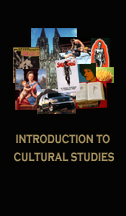unit five:
The Hollywood Western: Semiotics,
Myth & Meaning
professor's
outline & study guide for roland barthes, "myth today"
Overview
of Roland Barthes' Mythologies:
a) Aim of Barthes' book/essay:
1. To bring methodology of semiology (Structuralist
study of signs) to popular culture
2. to make explicit what often remains implicit
in the texts and practices of popular culture
3. to interrogate the "falsely obvious"
and the "what-goes-without-saying"
4. to explain the theoretical assumptions
behind the study of popular culture
b) MYTH-defined preliminary as a technical term (not the synonym
of the false or fake)
1. Myth-ideology understood as ideas or
practices which defend the status quo and actively promote the interests
and values of the dominant classes in society
2. Myth-the turning of the cultural and
historical into the natural, the taken-for-granted.
Roland
Barthes , "Myth Today" pp. 109-118 of Cultural Theory and Popular
Culture
1)
MYTH is a type of speech:
a) Myth is a system of communication.
b) Myth is a mode of signification.
c) The object of its message does not define myth, but by the way
in which it utters this message.
d) Myth is not confined to oral speech-it can consist of modes of
representation; that is cinema, photography, sport, publicity, etc.
e) The science of studying Myth is semiology.
2) Myth is a semiological system.
a) Semiology postulates a relation between 2 terms: signifier and
signified.
b) The 3rd term is the correlation that unites the first two (signifier
+ signified = sign)
3) Myth is a second-order semiological system.
a) Myth is the META-LANGUAGE in which one speaks about the first
semiological system.
b) First Order System: signifier + signified = sign(1)
c) Second Order System: signifier(1) = Signified (2) = SIGN (2)
4) Therefore, the semiologist can treat writing and pictures in
the same way: they are both signs. Two examples of mythical speech:
a) grammar textbook example: "my name is lion"
b) magazine cover photo of black soldier saluting French flag
5)
Reading and Deciphering Myth
a) "Journalistic Reading" -- focus on symbols: reading is static,
makes intention obvious, cynical (Plato's cave-dweller)
b) "Mythologistic Reading" -- focus on full signifier, undoes the
signification of the myth by considering the distortion the form
imposes on the meaning; reading is static, unmasks intentions, demystifies
(Plato's returned prisoner)
c) "Semiological/Philosophical Reading" - focus on the signifier
as a whole comprised of meaning and form; consumes myth according
to its own structure; reading is dynamic; myth is seen at the same
time as both true and unreal (OUR task in this class)
7) Essential Function of Myth: Naturalization of the concept
a) Myth is experienced as innocent speech NOT because its intentions
are hidden, but because they are NATURALIZED
b) What allows the reader to consume myth innocently: myth seems
an inductive (natural) system not a semiotic one
6) Myth redefined:
a) Myth has the task of giving an historical intention a natural
justification
b) Myth has the task of making contingency appear eternal
c) Myth is constituted by the loss of the historical quality of
things: in myth, things lose the memory that they once were made
d) Semiological definition of myth: MYTH IS DEPOLITICIZED SPEECH


